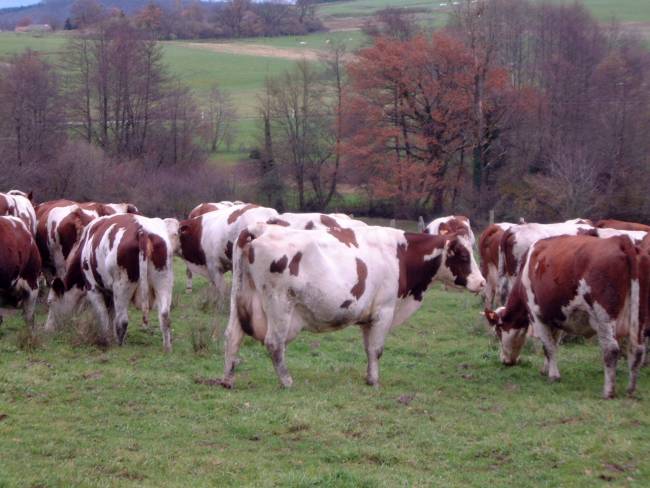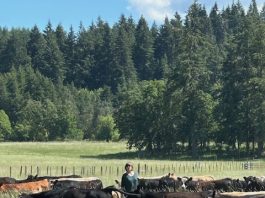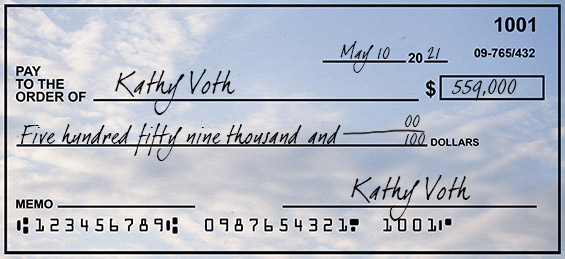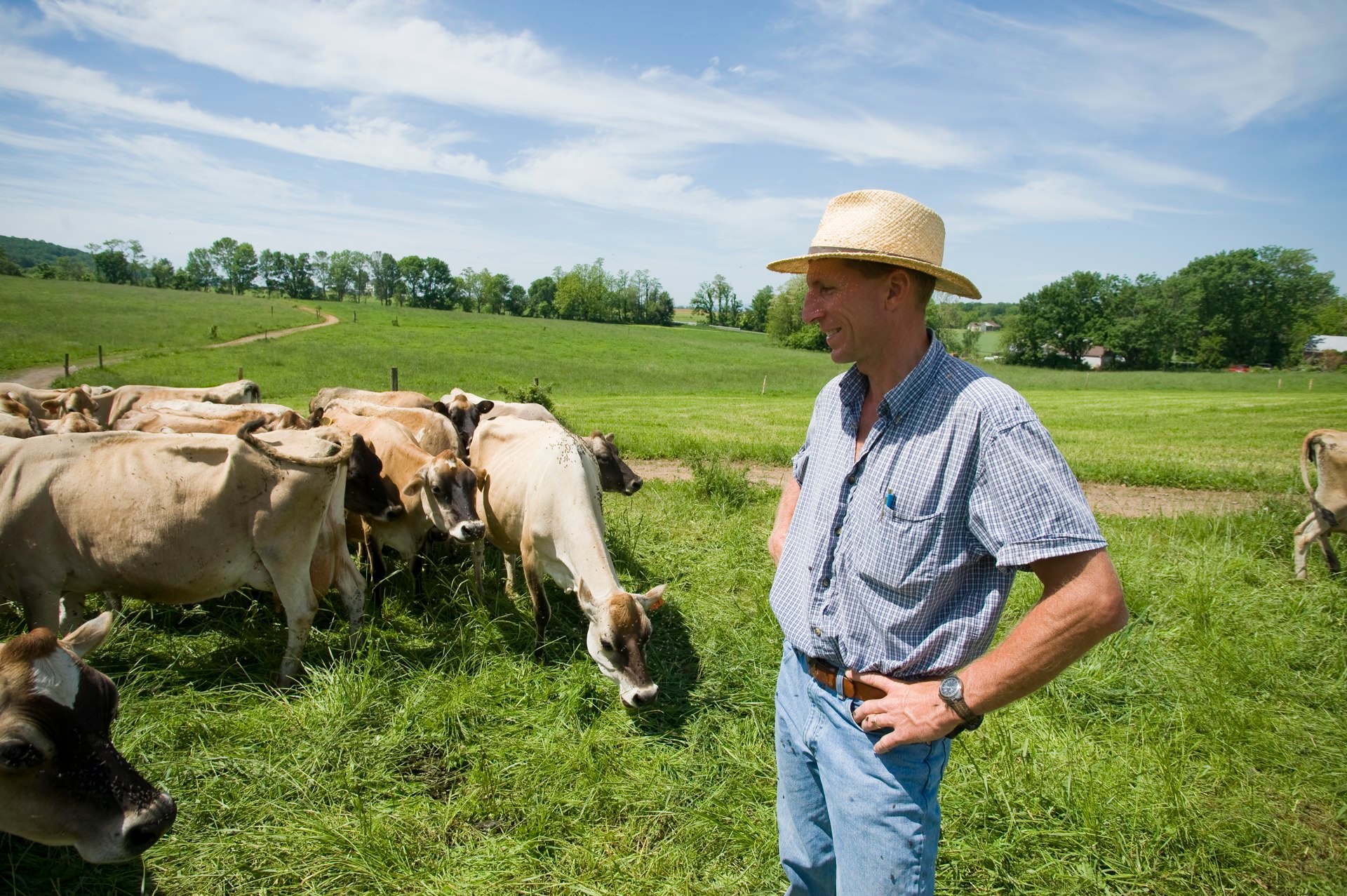

“Every dairy farmer is a beef farmer, they just don’t want to admit it,” says Myron Martin of Peace Hollow Farm, an organic, grassfed dairy in Maryland. So, though Martin is a dairy farmer, he’s breeding his herd to work in both markets. He sells beef alongside dairy products at his farm stand trailer, which he describes as a “redneck drive-thru,” and via wholesale around his local area.
Myron started thinking about the dual purpose of his herd when two women visited his farm and asked him if beef cows made different milk than dairy cows. They don’t. It’s a common misconception, he realized. Then, thinking about it, he realized every cow on his farm was going to be beef at some point. So building a dual purpose herd became part of his management strategy, and he started working toward a herd that would be well suited for beef and for dairy.

What Martin looks for in an animal and in a breed, he explains, is an animal that does well on grass. He also likes a “wide front end” because that means animals with big lungs, and big nose holes. He chuckled a little to think how that sounds, but the truth is, he wants them to have good breathing abilities. He also likes a brisket that hangs down to knees. Other farmers he’s talked to, in northern Wisconsin, look for larger animals to get through the longer cold winters, but that’s not something he needs to do in Maryland.

To build his dual-purpose herd, Martin is trying our a number of different breeds paying attention to both milk and beef production. He’s tried crossing his Jersey Fresian Holstiens with stock from Fleckvieh, a dual purpose breed from Central Europe, and Montbeliarde, a French breed used mainly for dairying and especially cheese making. Other breeds he’s interested in are Swedish Red and Norwegian Red. The Brown Swiss didn’t work well for him, but his vet suggested that it probably wasn’t the right Brown Swiss family. Other breeds Myron’s got his eye on include breeds, like MRY (Meuse Rhine Yssel), a dairy and meat breed from the Netherlands and the Lineback and Dutchbelt. He does research and he talks to a lot of other farmers with those breeds while he’s planning breeding.
Myron has found that the dual purpose cows usually dry themselves off after about six months. They have a longer dry period than a more dairy-oriented cow at about two months, and during that dry period, he likes to see them put on a good bit of weight. If they have more weight at the start of the next lactation, he’s found they do a lot better, and says “the dry period is not all wrong” as it serves a purpose for supporting the next lactation.
Adding beef to his operation has been simple. Instead of selling his bull calves to someone else, Myron keeps them and raises them with his herd. They graze and grow with the dairy heifers. Culls from his dairy herd become hamburger and tenderloin. It’s also been a profitable venture. Thanks to adding beef to his dairy operation, he’s been able to add about 20% more income onto the farm, and employ two more people.
Instead of selling his bull calves to someone else, Myron keeps them and raises them with his herd. They graze and grow with the dairy heifers. Culls from his dairy herd become hamburger and tenderloin. He aims for and usually gets about 300-350 lbs per side, which is what most of his beef-raising neighbors get as well. The beef graze with the heifers, and so production costs are a little difficult to ferret out. To his advantage, a neighbor is an expert farm management specialist, and he and Mr. Martin go over the books together. The beef bring about 20% more income onto the farm, and they employ his daughter and another employee as well.
Interested in Dual Purpose Breeds? Here Are Some More to Consider
There are a lot of breeds that are known as dual purpose. The compact Dexter, bred in southern Ireland produces milk high in solids, good for making butter and cheese, as well as yielding a lean, high quality beef. Devon cattle are known as easy keepers, thriving on grass. They are good dual purpose animals, and have also been used as draft animals, making them truly multipurpose cattle. We can thank Vikings for Normande cattle. In the 9th and 10th century, Viking conquerors brought cattle to Normandy, and their herd evolved into the Normande, a breed which does well on rough terrain, and high elevations. Since the Normandes have small heads, they yield a high proportion of their carcass for beef.
Some breeds started as dual purpose, and split off into multiple breeds with targeted uses. Shorthorns were used for milk and beef, and then they were divided into two breeds, Milking Shorthorn and Beef Shorthorn, or just plain Shorthorn for short. Devon did this too, so now there are Milking Devons as well. Red Poll, Pineywood, and Randall or Randall Linebacks are also good dual breeds. And this is just a start.
Dual purpose breeds aren’t going to beat out a dairy bred for milk production, nor will they out produce cattle raised for beef production. They fit well on farms that want to diversify. Dual purpose breeds are more common in Europe and the UK, but they’re gaining in popularity in North America.
Estimates are that 20% of US beef in the grocery store was originally raised for dairy. Many dairy farms already do get some income from beefing their cows. With the potential to make this an additional business, breeding and farming for beef and dairy might be a worthwhile endeavor





We run a herd of British Friesian cows which are excellent dual purpose cattle. Cows are relatively productive and cows can last to 15 years old. They can regularly live to 10 years plus. This makes a great saving on replacements plus you have the beef calf to rear or sell. The milk quality is slightly better as there is slightly less milk quantity. Great article!
Comments are closed.